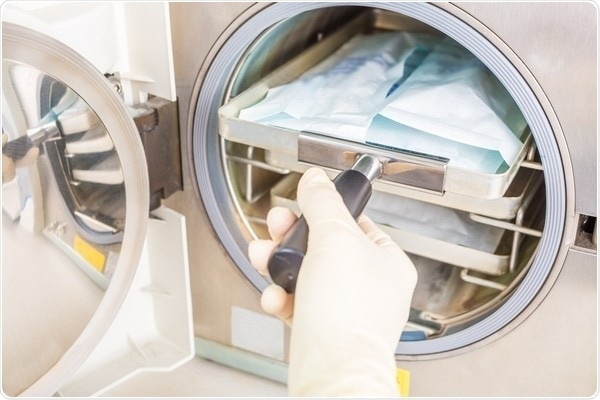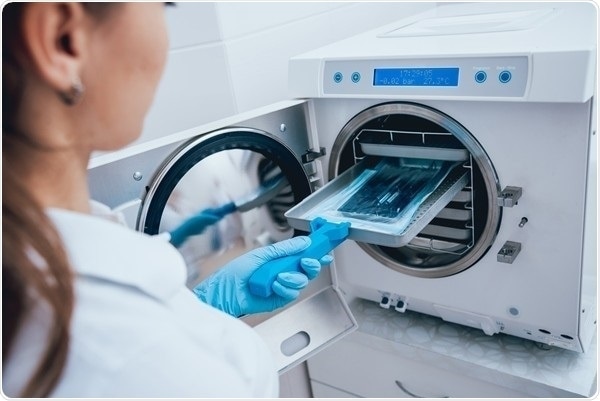Medical devices are required to maintain a consistently high level of sanitation at any cost, but these products are regularly in contact with harmful organisms and dangerous bacteria. When not sterilized, medical devices can serve as vectors of disease.
Barrier membranes and films serve as the first line of defense in a wide range of medical applications, including medical liners, drug containment and fluid bags.
Advantages of fluoropolymer films
Fluoropolymer films typically serve as the barrier material of choice, regardless of the medical setting. Fluoropolymer films generally offer an array of beneficial properties, making them popular candidates for medical applications. These properties include:
- Resistance to low and high temperatures
- Resistance to cracking
- Chemical inertness
- Biocompatibility
- Flexibility
- Anti-stick surfaces
- Low coefficient of friction
- FDA and USP (United States Pharmacopeia) compliant

Image Credit: Shutterstock
The optimal choice of fluoropolymer film can vary based on its final application, but manufacturers generally choose PFA (perfluoroalkoxy polymer), FEP (fluorinated ethylene-propylene), PTFE (polytetrafluoroethylene), ETFE (polyethylenetetrafluoroethylene) or ECTFE (polyethylenechlorotrifluoroethylene).
Each fluoropolymer offers the advantages outlined here, so medical manufacturers’ selections will largely depend on final application, strength, cost and any considerations around the manufacturing process.
For example, PTFE films are a good choice for applications that need high-temperature resistance and chemical resistance. PFA films also offer these properties but in transparent form. PFA can also be thermoformed, heat-sealed, welded, metalized or laminated to a wide range of materials.
FEP films are easy to fabricate while offering excellent chemical resistance and release properties. They are also well suited to use in high-temperature and cryogenic applications.
ETFE film boasts excellent weatherability. It is frequently employed in release applications but is also well suited to use in high temperature and cryogenic applications.
ECTFE is resistant to weathering and high energy radiation, making it a popular fluoropolymer film for lightweight and high-strength composite fabrication.
Medical sterilization
Medical device manufacturers should investigate the properties of individual barrier film materials to ensure these meet specific application challenges. However, sterilization should also be considered.
When there is a need for medical devices coated with barrier films to be repeatedly sterilized, manufacturers must evaluate the film’s long-term performance in light of this sterilization.
Considerations will vary based on the sterilization method and the type of fluoropolymer used, adding a further layer of complexity to the design and manufacturing process.
Fluoropolymer films can be damaged by repeated harsh sterilization, potentially prompting them to warp or discolor. Understanding how fluoropolymers will perform under different sterilization methods will help manufacturers ascertain the most suitable film material for an application.

Image Credit: Shutterstock
The majority of sterilization methods can be classified as chemical, physical or radiation. Professionals will select an appropriate sterilization method based on a number of conditions, such as the economics of the process and the volume of products to be sterilized.
Physical sterilization is typically performed in an autoclave. Humidity, heat and pressure are used to thoroughly clean objects, with the majority of autoclave sterilizations taking between 15 minutes to over 1 hour, depending on the level of cleaning required and the pressure used.
Chemical sterilization makes use of either ethylene oxide (EtO) or chlorine dioxide (CD) gas. Both versions of this process involve cycling devices through a range of time-consuming steps, including the introduction of chemical and air washes.
While this method is efficient at eliminating a wide range of bacteria, use of toxic chemicals and the time taken to thoroughly sterilize equipment make these methods impractical for many operating conditions.
Most fluoropolymer films will perform well under chemical sterilization, but the growing call for decreased toxic material use is reducing demand for this approach.
Radiation sterilization – particularly gamma ray sterilization – has become increasingly popular among users of medical devices and equipment in recent years.
This method sees items exposed to a strong gamma radiation source to kill contaminants. Electron beam sterilization – which uses cathode rays – is also a common choice among many users.
Gamma ray radiation offers numerous advantages over other sterilization methods, particularly in terms of time efficiency.
It could become the industry’s method of choice, but its downside is that radiation sterilization can have an adverse impact on the polymer film coating in addition to the harmful organisms it is designed to eliminate.
The exact nature of this issue depends on the coating used, radiation levels and many other factors.
The growing popularity of radiation sterilization – particularly gamma ray – is prompting manufacturers to evaluate frequently used fluoropolymer films and assess how each of these endures sterilization techniques.
The impact of radiation sterilization
High-energy radiation stemming from X-rays, gamma rays and electron beams have a handful of fundamental effects on fluoroplastics. It can affect elongation, tensile strength, impact resistance and shear strength.
Each polymer will react to radiation differently, with these characteristics, as well as odor and color, potentially being impacted differently.
Polymers typically undergo one of two changes under radiation: scission or cross-linking.
Polymer scissions can lead to impaired toughness and elongation, while cross-links enhance strength and stiffness.
Both of these reactions occur simultaneously, but one will be more dominant depending on the polymer in question. These effects are more pronounced at higher temperatures and in air, as opposed to in a vacuum.
The radiation dosage required to produce these negative effects will depend on the polymer, but this may also be impacted by residual or functional stress from factors such as design and production, dose rate, the product cross-section thickness or the radiation dose absorbed.
The polymer’s chemical composition, its morphology (its percent crystallinity), the device design (for example, its physical dimensions) and post-radiation storage environment conditions (for example, the oxygen atmosphere and temperature) also affect films’ degradation.
Discoloration (usually yellowing) can often be observed prior to loss of properties, indicating potential issues.
A key challenge when determining the ideal film to employ lies in understanding at what point the material has degraded to an unusable state.
The industry standard is generally understood to be a 25% reduction in tensile strength or related parameters before a material should be discarded.
Fluoroplastic films are classified as ‘good,’ ‘better’ or ‘best,’ according to their specific performance characteristics.
Partially fluorinated fluoropolymers, such as ETFE and ECTFE, typically exhibit improved performance under radiation sterilization than fully fluorinated ones, such as PTFE, PFA and FEP.
A comparative ranking, from most to least favorable, can be seen below:
- ECTFE
- ETFE
- FEP
- PFA
- PTFE
The right choice
Selecting the ideal fluoropolymer films for medical applications depends on a number of variables, including the sterilization methods in use.
The right choice of manufacturer can help extend the life of both films and devices, even when working with harsh and repeated sterilization procedures.
Versiv Films can assist medical device manufacturers in choosing the most suitable polymer film for any application.
The company’s engineers have designed and tested each material option, so manufacturers can be confident that their selection is high quality and ideally suited to the application in question.
About Versiv Composites Limited
Versiv™ is a recognized expert in high-performance, technology-driven, composite films and fabric solutions. Through our ability to provide proven products and customized solutions we serve customers across a diverse array of sectors.
Our composite materials encompass a broad range of high-performance material solutions on the market, designed and manufactured with the most demanding applications in mind. At the core of our offering is our expertise in films and fabrics composites and true versatility of the products that we offer.
Sponsored Content Policy: News-Medical.net publishes articles and related content that may be derived from sources where we have existing commercial relationships, provided such content adds value to the core editorial ethos of News-Medical.Net which is to educate and inform site visitors interested in medical research, science, medical devices and treatments.